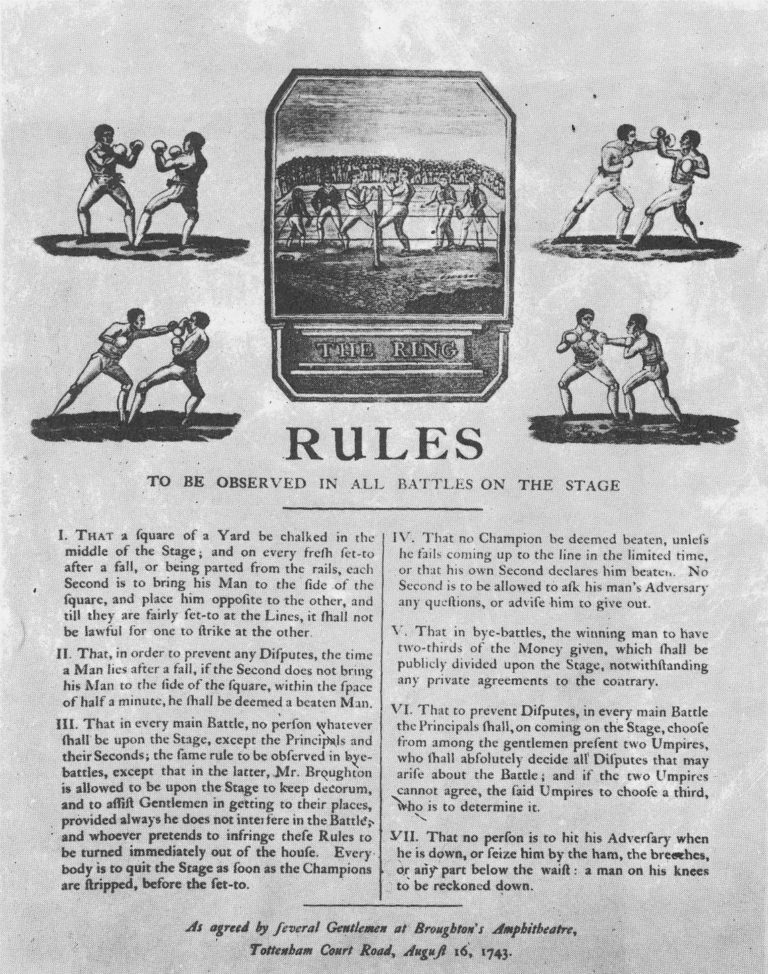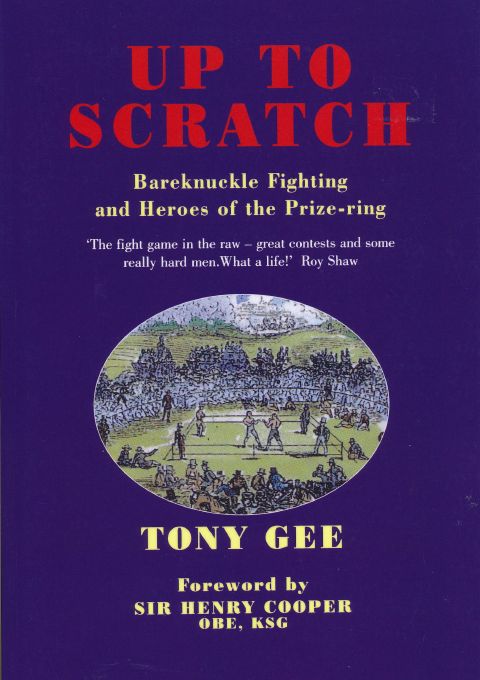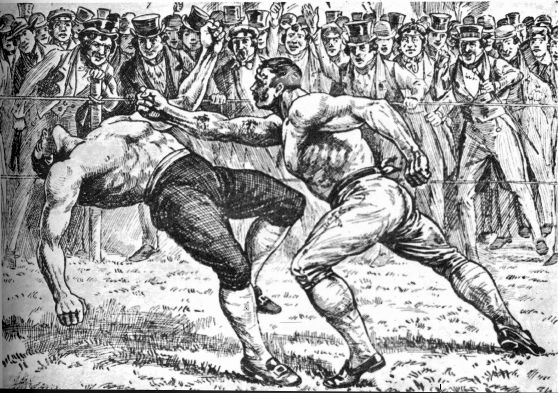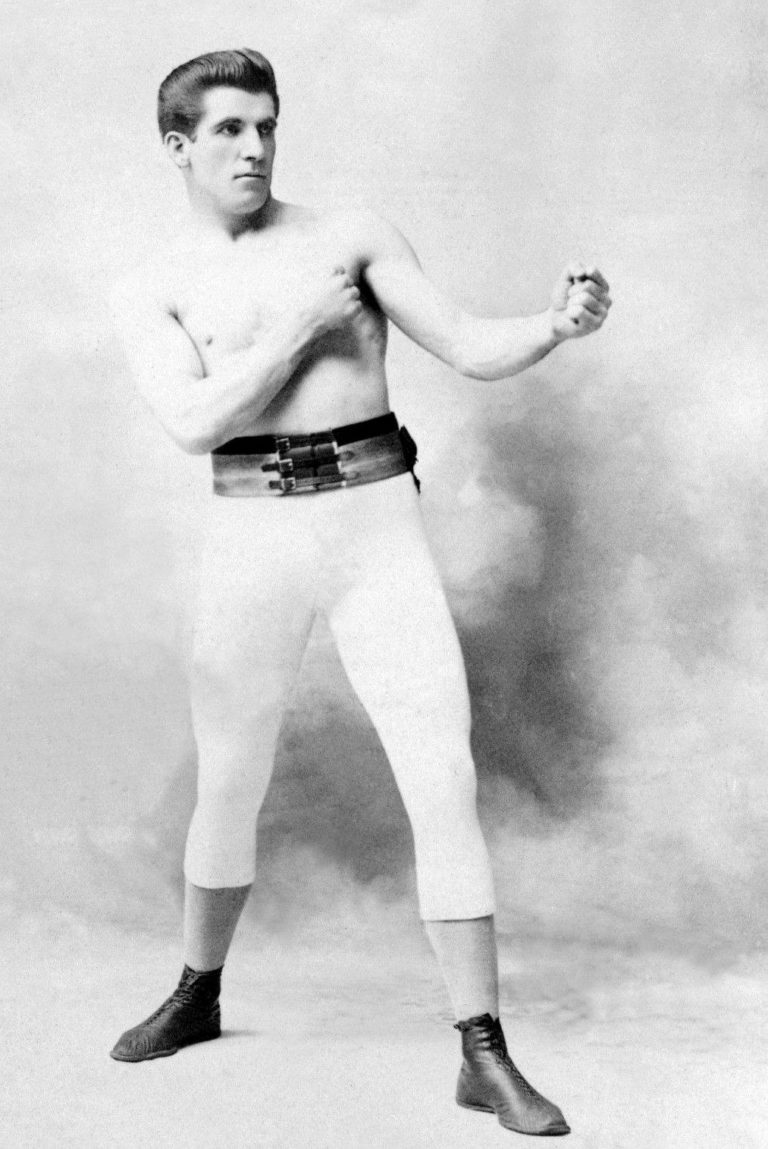Prize Ring Rules
Broughton's Rules (1743)
Broughton’s Rules (1743), which laid down the first code of practices for the prize-ring.
Rules to be Observed in all Battles on the Stage:
- That a square of a yard be chalked in the middle of the stage; and every fresh set-to after a fall, or being parted from the rails, each second is to bring his man to the square and place him opposite to the other; and till they are fairly set-to at the lines, it shall not be lawful for one to strike the other.
- That in order to prevent any disputes as to the time a man lies after a fall, if the second does not bring his man to the side of the square within the space of half a minute he shall be deemed a beaten man.
- That, in every main battle, no person whatever shall be upon the stage, except the principals and their seconds; the same rule to be observed in the bye-battles, except that in the latter Mr. Broughton is allowed to be upon the stage to keep decorum, and to assist gentlemen in getting to their places; provided always he does not interfere in the battle; and whoever presumes to infringe these rules to be turned immediately out of the house. Everybody is to quit the stage as soon as the champions are stripped, before they set-to.
- That no champion be deemed beaten, unless he falls coming up to the line in the limited time; or that his own second declares him beaten. No second is to be allowed to ask his man’s adversary any questions or advise him to give out.
- That in the bye-battles, the winning man to have two-thirds of the money given, which shall be publicly divided upon the stage, notwithstanding any private agreement to the contrary.
- That to prevent disputes, in every main battle, the principals shall, on the coming on the stage, choose from among the gentlemen present two umpires, who shall absolutely decided all disputes that may arise about the battle; and if the two umpires cannot agree, the said umpires to choose a third, who is to determine it.
- That no person is to hit his adversary when he is down, or seize him by the ham, the breeches, or any part below the waist; a man on his knees to be reckoned down.

'New Rules' of 1838
These considerably more comprehensive rules were introduced as a result of the death of William Phelps (known as ‘Brighton Bill’) at the hands of Owen Swift. They superseded the rudimentary Broughton’s Rules (the main emphasis of which had been on fair gaming, rather than the protection of fighters).
N.B. Now commonly referred to as the ‘London Prize Ring Rules’, but significantly were not so in England when they originally came into operation there (this generally being a later 19th century term, and in fact then one, it seems, not usually favoured quite as much in England as in other countries).
The main changes included the following:
- Stipulations were made as to how the ring should be formed (notably size and that it should now be done so on turf).
- The ‘square of a yard’ in Broughton’s Rule 1 was replaced by the ‘scratch’ line.
- After the 30 seconds between rounds, and the umpire’s call of ‘Time’, each man was required to walk to the scratch unaided and was allowed eight seconds to do so. This prevented a fighter being carried to the scratch who was, in reality, unfit to continue.
- A man wilfully going down without a blow was deemed to have lost the battle.
- Fouls such as butting, gouging, biting, scratching, kicking, etc. were now included (having previously been considered, at the very least, ‘unmanly’).
- Provisions were made in the case of such events as interference by the law or darkness.
- ‘Colours’ were introduced.

[Dowling, Vincent], Fistiana; or, The Oracle of the Ring (1841), pages 28, 62-66
Gee, Tony, Up to Scratch: Bareknuckle Fighting and Heroes of the Prize-ring (1998, 2001 & 2014), page 15
Gee, Tony, ‘A Chronological List of the Most Significant Contests in England and America During the Bareknuckle Era of Pugilism’, IBRO Journal December 2019, pages 17-18
Swift, Owen, The Hand-book to Boxing; being a Complete Instructor in the Art of Self-defence (1840), pages 24-26
Young England, The Yorkshire Fancy-ana, for 1845, Comprising a Faithful Record of the Ring and the Turf [1845?], pages 15, 30-33
Bell’s Life in London and Sporting Chronicle, July-December 1838
Courtesy of Bareknuckle Historian Tony Gee
'New Rules' of 1853
‘New Rules’ of 1853 succeeded and built upon the ‘New Rules’ of 1838.
N.B. Now commonly referred to as the ‘London Prize Ring Rules’, but significantly were not so in England when they originally came into operation there (this generally being a term adopted a little later, and in fact then one, it seems, not usually favoured quite as much in England as in other countries).
The new rules of the Ring
The following are the new rules of the Ring, as revised at the general meeting of the Pugilistic Benevolent Association, on Wednesday week:
- That the ring shall be made on turf, and shall be four-and-twenty feet square, formed of eight stakes and ropes, the latter extending in double lines, the uppermost line being four feet from the ground, and the lower two feet from the ground. That in the centre of the ring a mark be formed, to be termed a scratch; and that at two opposite corners, as may be selected, spaces be enclosed by other marks sufficiently large for the reception of the seconds and bottle-holders, to be entitled “the corners.”
- That each man shall be attended to the ring by a second and a bottle-holder, the former provided with a sponge, and the latter with a bottle of water. That the combatants on shaking hands, shall retire until the seconds of each have tossed for choice of position, which adjusted, the winner shall choose his corner according to the state of the wind or sun, and conduct his man thereto, the loser taking the opposite corner.
- That each man shall be provided with a handkerchief of a colour suitable to his own fancy, and that the seconds proceed to entwine these handkerchiefs at the upper end of one of the centre stakes. That these handkerchiefs shall be called “the colours;” and that the winner of the battle at its conclusion shall be entitled to their possession as the trophy of victory.
- That two umpires shall be chosen by the seconds or backers to watch the progress of the battle, and take exception to any breach of the rules hereafter stated. That a referee shall be chosen by the umpires, unless otherwise agreed on, to whom all disputes shall be referred; and that the decision of this referee, whatever it may be, shall be final and strictly binding on all parties, whether as to the matter in dispute or the issue of the battle. That the umpires shall be provided with a watch, for the purpose of calling time; and that they mutually agree upon which this duty shall devolve, the call of that umpire only to be attended to, and no other person whatever to interfere in calling time. That the referee shall withhold all opinion till appealed to by the umpires, and that the umpires strictly abide by his decision without dispute.
- That on the men being stripped, it shall be the duty of the seconds to examine their drawers, and if any objection arise as to insertion of improper substances therein, they shall appeal to their umpires, who, with the concurrence of the referee, shall direct what alterations shall be made.
- That in future no spikes be used in fighting boots except those authorised by the Pugilistic Benevolent Association, which shall not exceed three-eights of an inch from the sole of the boot, and shall not be less than one-eight of an inch broad at the point; and, it shall be in the power of the referee to alter, or file in any way he pleases, spikes which shall not accord with the above dimensions, even to filing them away altogether.
- That both men being ready, each man shall be conducted to that side of the scratch next his corner previously chosen; and the seconds on the one side, and the men on the other, having shaken hands, the former shall immediately return to their corners, and there remain within the prescribed marks till the round be finished, on no pretence whatever approaching their principals during the round, under penalty of 5s. for each offence, at the option of the referee. The penalty, which will be strictly enforced, to go to the funds of the association. The principal to be responsible for every fine inflicted on his second.
- That at the conclusion of the round, when one or both of the men shall be down, the seconds and bottle-holders shall step forward and carry or conduct their principal to his corner, there affording him the necessary assistance, and that no person whatever be permitted to interfere with this duty.
- That on the expiration of thirty seconds (unless otherwise agreed upon) the umpire appointed shall cry “Time,” upon which each man shall rise from the knee of his bottle-holder and walk to his own side of the scratch unaided, the seconds and bottle-holders remaining in their corner; and that either man failing so to be at the scratch within eight seconds shall be deemed to have lost the battle.
- That on no consideration whatever shall any person be permitted to enter the ring during the battle, nor till it shall have been concluded; and that, in the event of such unfair practice, or the ropes and stakes being disturbed or removed, it shall be in the power of the referee to award the victory to that man who, in his honest opinion, shall have the best of the contest.
- That the seconds and bottle-holders shall not interfere, advise, or direct the adversary of their principal, and shall refrain from all offensive and irritating expressions, in all respects conducting themselves with order and decorum, and confine themselves to the diligent and careful discharge of their duties to their principals.
- That in picking up their men, should the seconds or bottle-holders wilfully injure the antagonist of their principal, the latter shall be deemed to have forfeited the battle on the decision of the referee.

- That it shall be “a fair stand-up fight,” and if either man shall wilfully throw himself down without receiving a blow, whether blows shall have previously been exchanged or not, he shall be deemed to have lost the battle; but that this rule shall not apply to a man who in a close slips down from the grasp of his opponent to avoid punishment, or from obvious accident or weakness.
- That butting with the head shall be deemed foul, and the party resorting to this practice shall be deemed to have lost the battle.
- That a blow struck when a man is thrown or down shall be deemed foul. That a man with one knee and one hand on the ground, or with both knees on the ground, shall be deemed down; and a blow given in either of those positions shall be considered foul, providing always, that when in such position, the man so down shall not himself strike or attempt to strike.
- That a blow struck below the waistband shall be deemed foul; and that, in a close, seizing an antagonist below the waist, by the thigh, or otherwise, shall be deemed foul.
- That all attempts to inflict injury by gouging, or tearing the flesh with the fingers or nails, and biting, shall be deemed foul.
- That kicking, or deliberately falling on an antagonist, with the knees or otherwise, when down, shall be deemed foul.
- That all bets shall be paid as the battle-money, after a fight, is awarded.
- That no person, on any pretence whatever, shall be permitted to approach nearer the ring than ten feet, with the exception of the umpires and referee, and the persons appointed to take charge of the water or other refreshment for the combatants, who shall take their seats close to the corners selected by the seconds.
- That due notice shall be given by the stakeholder of the day and place where the battle-money is to be given up, and that he be exonerated from all responsibility upon obeying the direction of the referee; and that all parties be strictly bound by these rules; and that in future all articles of agreement for a contest be entered into with a strict and willing adherence to the letter and spirit of these rules.
- That in the event of magisterial or other interference, or in case of darkness coming on, the referee shall have the power to name the time and place for the next meeting, if possible on the same day, or as soon after as may be.
- That should the fight not be decided on the day, all bets, instead of being drawn, shall be put together and divided, unless the fight shall be resumed the same week, between Sunday and Sunday, in which case the bets shall stand and be decided by the event. That where the day named in the articles for a fight to come off is altered to another day in the same week, bets shall stand. The battle-money shall remain in the hands of the stakeholder until fairly won or lost by a fight, unless a draw be mutually [agreed] upon.
- That any pugilist voluntarily quitting the ring previous to the deliberate judgment of the referee being obtained, shall be deemed to have lost the fight.
- That on an objection being made by the seconds or umpire, the men shall retire to their corners, and there remain till the decision of the appointed authorities shall be obtained; that if pronounced “foul,” the battle shall be at at [sic] end, but if “fair,” “time” shall be called by the party appointed, and the man absent from the scratch in eight seconds after shall be deemed to have lost the fight. The decision in all cases to be given promptly and irrevocably, for which purpose the umpires and the referee should be invariably close together.
- That if in a rally at the ropes a man steps outside the ring, to avoid his antagonist, or escape punishment, he shall forfeit the battle.
- That the use of hard substances, such as stones, or sticks, or of resin, in the hand during the battle shall be deemed foul, and that on the requisition of the seconds of either man, the accused shall open his hands for the examination of the referee.
- That where a man shall have his antagonist across the ropes in such a position as to be helpless, and to endanger his life by strangulation or apoplexy, it shall be in the power of the referee to direct the seconds to take their man away, and thus conclude the round, and that the man or his seconds refusing to obey the direction of the referee, shall be deemed the loser.
- That all stage fights be as nearly as possible in conformity with the foregoing rules.
Bell’s Life in London and Sporting Chronicle 25 December 1853, page 6
Courtesy of Bareknuckle Historian Tony Gee
Marquess of Queensberry Rules
Governing Contests for Endurance (1865)*
N.B. Named after the then 8th, but now considered 9th, Marquess of Queensberry (John Sholto Douglas, 1844-1900). The Marquess of Queensberry Rules were written by John Graham Chambers, not the lightweight champion Arthur Chambers as has sometimes been erroneously claimed. Any degree of input, though, from the Marquess himself is a matter of some debate.
* The year 1865 is in question here, as no fights under these endurance rules for professionals appear to have occurred as early as this. Moreover, the amateur rules are generally regarded as having come first, with adaptation and gradual adoption for professional purposes following later, and the former were not framed any earlier than that year (but almost certainly afterwards, although the actual date for them has not been categorically proved beyond all possible doubt). It was, in fact, the contention of the Marquess’s grandson that (what would have been professional) rules were passed by a “committee of the Pugilists’ [sic] Benevolent Association in 1866” (but then perhaps it should be noted that he was guilty of wrongly naming Arthur Chambers as the man his grandfather “chose to help him frame the rules that were destined to revolutionize the fight game”). Incidentally, general confusion regarding the regulations under which professional gloved fights took place was not originally especially unusual, The Sportsman, reporting on Tom Allen’s contest with Tompkin Gilbert as late as 1877, for instance, stating that it was “not fought in accordance with either the Queensberry or the old rules”.
The Rules:
- To be a fair stand-up boxing match, in a 24-foot ring, or as near that size as practicable.
- No wrestling or hugging allowed. The rounds to be of three minutes’ duration, and one minute time.
- If either man fall, through weakness or otherwise, he must get up unassisted, ten seconds to be allowed him to do so, the other man meanwhile to retire to his corner, and when the fallen man is on his legs the round is to be resumed and continued until the three minutes have expired, and if one man fails to come to the scratch in the ten seconds allowed, it shall be in the power of the referee to give his award in favor of the other man.
- A man hanging on the ropes in a helpless state, with his toes off the ground, shall be considered down. No seconds or any other person to be allowed in the ring during the rounds.
- Should the contest be stopped by any unavoidable interference, the referee to name time and place for finishing the contest as soon as possible, so that the match must be won or lost, unless the backers of both men agree to draw the stakes.
- The gloves to be fair-sized boxing gloves of the best quality, and new.
- Should a glove burst or come off, it must be replaced to the referee’s satisfaction.
- A man on one knee is considered down, and if struck is entitled to the stakes.
- No shoes or boots with spikes allowed.

Edwards, William, Art of Boxing and Science of Self-defense, together with a Manual of Training (1888), pages 109-110
Queensberry, the Tenth Marquess of, The Sporting Queensberrys (1942), pages 117, 120
The Sportsman 30 October 1877, page 3
Courtesy of historian Tony Gee (who notes that the above-mentioned grey areas, amongst others, point to a definite necessity for further in-depth study of the background and early history of the Rules).